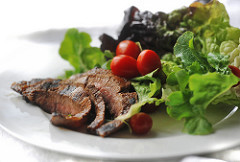 You have probably heard a lot about the benefits of the “Paleo Diet.” Advocates explain that humans are genetically adapted to eating the specific foods that were readily available to our ancestors. They claim that many of today’s diet-related illnesses occur because our bodies are not well suited for the changes introduced by farming and agriculture.
You have probably heard a lot about the benefits of the “Paleo Diet.” Advocates explain that humans are genetically adapted to eating the specific foods that were readily available to our ancestors. They claim that many of today’s diet-related illnesses occur because our bodies are not well suited for the changes introduced by farming and agriculture.
Should you consider trying the paleo diet? Many people, including well-known athletes, have used it with great success.
What is the paleo diet?
Paleo is short for Paleolithic, the time period as known as the Stone Age. Sometimes it is called the “Hunter Gatherer” or “Caveman” diet since it depends mainly on natural foods that can be hunted or gathered. It may also be called the primal blueprint.
The paleo food list includes, for example, lean meat, chicken, fish, nuts, fruits and vegetables (especially root vegetables, except for potatoes and yams). It aims to replicate, as closely as possible, the foods eaten by early humans before the beginning of agriculture and raising livestock.
The premise of the paleo solution is that prehistoric people evolved over time to eat certain foods. What and how we eat has changed much faster than our genes could possibly adapt, and we may be healthier if we consume foods that more closely match our genetic nature.
Many studies have linked our modern diet to disease and obesity. Paleo foods are highly nutritious compared to our modern diets, which include overly processed foods filled with additives. Also avoided are foods related to agriculture, like grains, dairy products, salt, sugar and animal fats. (If you are concerned about excessive protein, emphasize the vegetables and fruits.)
It’s easy to get started with the tasty recipes in this Paleo Cookbook.
Benefits of the paleo diet
Advocates say there are many healthy aspects to this way of eating:
- It is lower in calories and carbohydrates than the typical American fare, and so may promote weight loss.
- If you emphasize the fruits and veggies, it also has high fiber content. The benefits of increasing fiber are well documented, including a lower risk of diabetes and heart disease. Fiber is also beneficial for losing weight.
- Many people have food allergies; this is a way to easily eliminate gluten and casein, common allergens in many foods today.
- And finally, since it is based on natural foods, it avoids unhealthy artificial colors, flavors and preservatives, as well as sugar, salt, hydrogenated oils and trans fat.
Give it a try and see how it works for you.
Potential issues with the paleo diet
The evolutionary claims don’t really stand up under scrutiny. Studies of different populations around the world demonstrate that humans actually evolved to be flexible eaters, and can be healthy with a wide variety of diets.
The evidence for excluding dairy, legumes and grains is mixed. Some people do have problems with dairy or gluten, but most of us can eat these things in moderation without any issues.
If you do want to try it, be aware that there are some potential issues.
- It can lead to nutritional deficiencies, including calcium and vitamin D, harming bone health.
- There is a risk of toxins from high fish consumption.
- Many people have trouble sticking to a very limited variety of foods long-term.
For more information, see wikipedia.org/wiki/Paleolithic_diet
